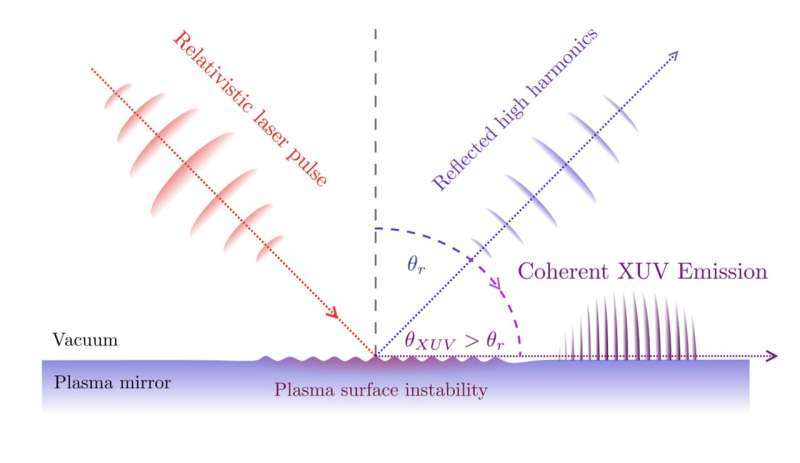December 1, 2023 feature
This article has been reviewed according to Science X's editorial process and policies. Editors have highlighted the following attributes while ensuring the content's credibility:
fact-checked
peer-reviewed publication
trusted source
proofread
An anomalous relativistic emission arising from the intense interaction of lasers with plasma mirrors

Interactions between intense laser pulses and plasma mirrors have been the focus of several recent physics studies due to the interesting effects they produce. Experiments have revealed that these interactions can generate a non-linear physical process known as high-order harmonics, characterized by the emission of extreme ultraviolet radiation (XUV) and brief flashes of laser light (i.e., attosecond pulses).
Researchers at The Extreme Light Infrastructure ERIC in Czechia and Osaka University in Japan recently uncovered a surprising transition that takes place during interactions between intense laser pulses and plasma mirrors. This transition, marked by an anomalous emission of coherent XUV radiation, was outlined in a paper published in Physical Review Letters.
"Relativistic oscillating mirrors are a fascinating concept with great potential for intense attosecond pulse and bright XUV generation," Marcel Lamač, one of the researchers who carried out the study, told Phys.org.
"We were reinvestigating some of the assumptions held in previous works and found that strong self-modulation can occur during the intense laser-mirror interaction, changing the properties of surface-emitted extreme ultraviolet (XUV) radiation, which can then propagate anomalously along the surface."
The interesting discovery by Lamač and his colleagues was made while they were testing predictions of previous work in the field. The team carried out various numerical, multidimensional particle-in-cell simulations at extremely high resolutions, with the goal of better understanding the interplay between electrons and ions during the interaction of solid density plasmas with intense lasers.
"One of the most immediate consequences of our work is that great care must be taken in target selection and pre-plasma control to prevent spatiotemporal coherence loss in the reflected high harmonics," Lamač said.
"Since we have found that the relativistic instability-modulated emission can be more efficient than the reflected high harmonics in the XUV range, this emission can be also considered as a potentially highly efficient XUV source, which would require as precise control of experimental conditions to achieve high yield of XUV emission."
The emission of XUV radiation that Lamač and his colleagues observed in their simulations has a unique and interesting property. Specifically, the researchers found that this coherent radiation propagates in parallel to the surface of the plasma mirror. Further calculations linked this anomalous emission to laser-driven oscillations of relativistic electron nanobunches originating from the instability of the plasma's surface.
"We believe that there is an interesting potential in potentially controlling this mirror self-modulation, where enhanced coherence could be achieved for more narrow-band coherent XUV generation in the initial stages of the surface instability," Lamač added.
This recent work by Lamač and his collaborators gathered new insight into the physical processes arising from the interaction between intense laser pulses and plasma mirrors. The results of the researchers' simulations could soon pave the way for more studies exploring the anomalous emission they observed, potentially leading to new interesting discoveries.
More information: M. Lamač et al, Anomalous Relativistic Emission from Self-Modulated Plasma Mirrors, Physical Review Letters (2023). DOI: 10.1103/PhysRevLett.131.205001
Journal information: Physical Review Letters
© 2023 Science X Network




















